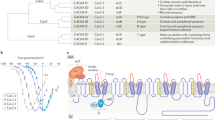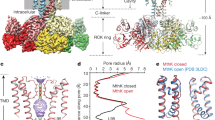Abstract
DIVERSE types of calcium channels in vertebrate neurons are important in linking electrical activity to transmitter release, gene expression and modulation of membrane excitability1. Four classes of Ca2+ channels (T, N, L and P-type) have been distinguished2–6on the basis of their electrophysiological and pharmacological properties. Most of the recently cloned Ca2+ channels7–16 fit within this functional classification. But one major branch of the Ca2+ channel gene family, including BII (ref. 15) and doe-1 (ref. 16), has not been functionally characterized. We report here the expression of doe-1 and show that it is a high-voltage-activated (HVA) Ca2+ channel that inactivates more rapidly than previously expressed calcium channels. Unlike L-type or P-type channels, doe-1 is not blocked by dihydropyridine antagonists or the peptide toxin ω-Aga-IVA, respectively. In contrast to a previously cloned N-type channel14, doe-1 block by ω-CTx-GVIA requires microm-olar toxin and is readily reversible. Unlike most HVA channels, doe-1 also shows unusual sensitivity to block by Ni2+. Thus, doe-1 is an HVA Ca2+ channel with novel functional properties. We have identified a Ca2+ channel current in rat cerebellar granule neurons that resembles doe-1 in many kinetic and pharmacological features.
This is a preview of subscription content, access via your institution
Access options
Subscribe to this journal
Receive 51 print issues and online access
$199.00 per year
only $3.90 per issue
Buy this article
- Purchase on Springer Link
- Instant access to full article PDF
Prices may be subject to local taxes which are calculated during checkout
Similar content being viewed by others
References
Hille, B. Ionic Channels of Excitable Membranes (Sinauer. Sutherland, MA, 1992).
Tsien, R. W. et al. Trends pharmacol. Sci. 12, 349–354 (1991).
Bean, B. P. A. Rev. Physiol. 51, 367–384 (1989).
Miller, R. J. & Fox, A. P. in Intracellular Calcium Regulation 97–138 (Wiley-Liss. New York, 1990).
Llinas, R. et al. Trends Neurosci. 15, 351–355 (1992).
Snutch, T. P. & Reiner, P. B. Curr. Opin. Neurobiol. 2, 247–253 (1992).
Tanabe, T. et al. Nature 328, 313–318 (1987)
Mikami, A. et al. Nature 340, 230–233 (1989).
Williams, M. E. et al. Neuron 8, 71–84 (1992)
Hui, A. et al. Neuron 7, 35–44 (1991).
Mori, Y. et al. Nature 350, 398–402 (1991).
Starr, T. V. B. et al Proc. natn. Acad. Sci. U.S.A. 88, 5621–5625 (1991).
Dubel, S. J. et al. Proc. natn. Acad. Sci. U.S.A. 89, 5058–5062 (1992).
Williams, M. E. et al. Science 257, 389–395 (1992).
Niidome, T. et al. FEBS Lett. 308, 7–13 (1992).
Horne, W. A. et al. Proc. natn. Acad. Sci U.S.A. 90, 3787–3791 (1993).
Campbell, K. P. et al. Trends Neurosci. 11, 425–430 (1988).
Catterall, W. A. Science 242, 50–61 (1988).
Ahmad, S. N. & Miljanich, G. Brain Res. 453, 247–256 (1988).
Horne, W. A., Hawrot, E. & Tsien, R. W. J. biol. Chem. 266, 13719–13725 (1991).
Carlson, S. S., Wagner, J. A. & Kelly, R. B. Biochemistry 17, 1188–1199 (1978).
Ngsee, J. K. et al. J. biol. Chem. 226, 2625–2680 (1991).
Fox, A. P. et al. J. Physiol., Lond. 394, 173–200 (1987).
Fox, A. P. et al. J. Physiol., Lond. 394, 149–172 (1987).
Hullin, R. et al. EMBO J. 11, 885–890 (1992).
Mintz, I. et al. Nature 355, 827–829 (1992).
Kasai, H. & Neher, E. J. Physiol., Lond. 448, 161–188 (1992).
Regan, L. J. J. Neurosci. 11, 2259–2269 (1991).
Narahashi, A. et al. J. Physiol., Lond. 383, 231–249 (1987).
Lemos, J. R. & Nowycky, M. C. Neuron 2, 1419–1426 (1989).
Wang, X. et al. J. Physiol., Lond. 445, 181–199 (1992).
Plummer, M. R. et al. Neuron 2, 1453–1463 (1989).
Salkoff, L. et al. Trends Neurosci. 15, 161–166 (1992).
Author information
Authors and Affiliations
Rights and permissions
About this article
Cite this article
Ellinor, P., Zhang, JF., Randall, A. et al. Functional expression of a rapidly inactivating neuronal calcium channel. Nature 363, 455–458 (1993). https://doi.org/10.1038/363455a0
Received:
Accepted:
Issue Date:
DOI: https://doi.org/10.1038/363455a0
This article is cited by
-
Skeletal Functions of Voltage Sensitive Calcium Channels
Current Osteoporosis Reports (2021)
-
Cav2.3 R-type calcium channels: from its discovery to pathogenic de novo CACNA1E variants: a historical perspective
Pflügers Archiv - European Journal of Physiology (2020)
-
Cysteines in the loop between IS5 and the pore helix of CaV3.1 are essential for channel gating
Pflügers Archiv - European Journal of Physiology (2010)
-
Calcium channel subtypes for cholinergic and nonadrenergic noncholinergic neurotransmission in isolated guinea pig trachea
Naunyn-Schmiedeberg's Archives of Pharmacology (2010)
-
Interaction of T-Type Calcium Channel CaV3.3 with the β-Subunit
Molecules and Cells (2010)
Comments
By submitting a comment you agree to abide by our Terms and Community Guidelines. If you find something abusive or that does not comply with our terms or guidelines please flag it as inappropriate.



